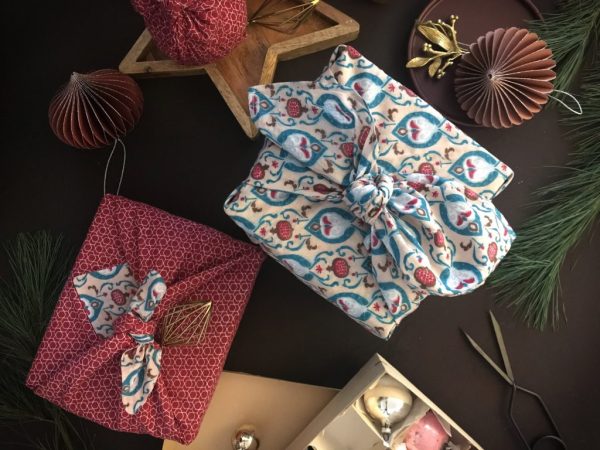I absolutely love the Christmas holidays; the food, the decorations and the festive cheer. Now I am no scrooge, but what I am a bit humbug about is the amount of waste that is left over. Household waste can increase more than 25% in the holiday season so it’s time to start looking at a more environmentally friendly Christmas.

Presents
Who doesn’t love opening a beautifully wrapped present? Gift giving is a quintessential part of Christmas but it seems to have gotten a little out of control with the average consumer looking to spend $767 on gifts this Christmas. With this in mind we need to be mindful of the gifts we are buying. It’s so easy to get carried away when you’re buying for people that you love, but maybe this year concentrate on gifts that have a positive impact on the environment. There are a few things to consider, the carbon footprint of your product; how was it made and did it need an airfare to get to you? Consider how much plastic is in the product and of course how it is packaged. With this in mind, consumers are more likely to do their shopping online than in stores this year which adds to our packaging problem. Think about going to your local stores and supporting smaller businesses who are trying to do some good.


As lovely as gift giving is, there is often a lot of stress surrounding this area of the holiday; people often buy presents just for the sake of filling a stocking or making it look like ‘enough’. In fact, within 6 months, only 1% of everything the average person buys is still in use, the other 99% has been discarded. So this year think quality over quantity and consider the environmental impact of the gifts you are buying. Truly less is more.


Wrapping
So you’ve carefully selected your sustainable gifts but now you want to wrap them. Before you get distracted by endless rolls of wrapping paper with cutesy festive prints, it’s worth noting that Canadians throw out 540,000 tonnes of wrapping paper after the holidays. The majority of wrapping paper is not locally recyclable, glossy and metallic types are the biggest culprits here. So if you love to wrap your gifts, look for wrapping paper made from recyclable materials and make sure that it can be recycled locally. Better yet go wrapping paper free, you can alway use things you’ve got lying around the house. I’m sure a lot of us have received gifts in various gift bags that we’ve held on to, which are probably collecting dust in a cupboard somewhere. Reuse what you have instead of buying more. If they aren’t particularly christmassy you can always get crafty and create some christmassy designs, plus you’ll get bonus points for adding a personal touch.


You can also use reusable material like a cloth- I know this doesn’t scream Christmas but trust me! There is a traditional Japanese cloth-folding technique called furoshiki, that allows you to wrap objects of various shapes and sizes in a single piece of cloth and it is truly beautiful. You can buy furoshiki fabric online and there are loads of videos and tutorials online. Honestly check it out, you will be mesmerised. In this way you are contributing to a waste free Christmas and your gifts will be wrapped in a unique and beautiful way. You can also use this technique on wrapping paper which eliminates the need for tape! Now sticky tape is basically sticky plastic and cannot be recycled. With Canadians using 6 million rolls of tape to wrap up Christmas presents every year it’s time to find alternatives. Look for recyclable plastic free products like paper tapes. If you really like the classic see through look, there is a plant based tape on the market which is made from cellulose, naturally based glue and it is recyclable. There are plenty of products out there to help us move towards a plastic free Christmas. We just have to be proactive and find them.


Food
Undoubtedly, one of the best parts of the Christmas holidays is the food. Unfortunately most of us will go overboard this Christmas and buy way too much. We’ll over fill our plates on Christmas Day and a lot of that delicious food will end up in the trash because our eyes are always too big for our bellies! Because of the festivities and the fact that we are too full to move, we often forget the impact that food waste has on the environment. Throwing away just a single portion of Christmas dinner produces the same carbon emissions as having your Christmas lights on every day in December. So when the big day comes don’t overfill your plate, you can always go back for more, and then the food that is leftover can be used for Boxing Day sandwiches – or whatever tradition follows in your household. Don’t forget about your freezer; lots of leftover food can be frozen and reheated in the future. Some food might not have even been touched, those three packs of unopened mince pies are unlikely to be consumed, don’t let them slowly go off in your cupboard. Go to your local food bank and donate your leftover food to those in need or check out food sharing apps in your local community.


Food packaging is already a big contributor to plastic pollution, never mind the increase in consumption over the holiday period. Christmas products are often overly packaged. It’s been found that packaging makes up approximately half of total weight of chocolate sold at Christmas. Take an advent calendar or a selection box as an example, the ratio of chocolate to packaging is pretty shocking. Around 125,000 tonnes of plastic food wrapping will be discarded over the festive period. Check out our blog on Plastic-Free Grocery Store Shopping for ideas on how to reduce your plastic consumption at the supermarket.


It may be the season to be jolly but unfortunately our planet disagrees. Being eco-friendly and trying to minimize waste during Christmas doesn’t mean that Christmas is cancelled or has to be a boring affair; we just have to adapt our needs for the benefit of the planet. We can still give gifts and have beautifully decorated houses. We just don’t need to buy more items that are made from and packaged in plastic. We are moving in the right direction; over 40 percent of holiday shoppers in Canada stated they avoid the use of plastic and single-use materials where possible due to concerns surrounding sustainability. Let’s keep this up and increase this percentage. We all know what damage these products are doing to our planet and how the majority of plastic that ends up in our oceans comes from land based products. Let’s try to keep our consumption down this Christmas by making more mindful, sustainable choices. Other options to keep plastic consumption down could even include donating to your local favourite charity as a gift or potentially supporting organizations who work to keep our environment safe. Whatever the case may be, it is important to stay plastic free and keep our home planet clean for our future.
Merry Christmas!
